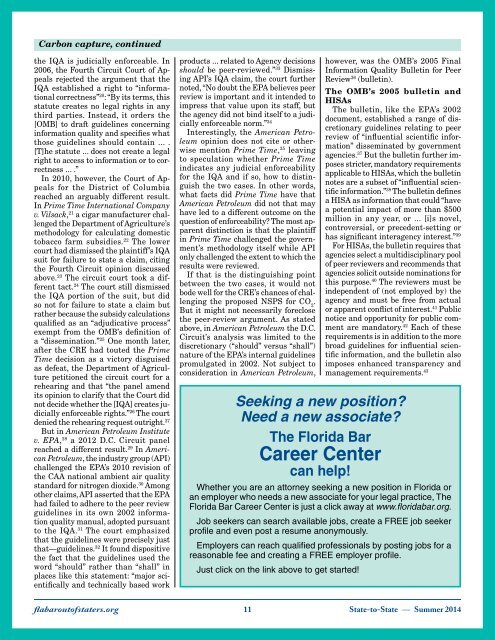OOS-2014-Summer-Final
OOS-2014-Summer-Final
OOS-2014-Summer-Final
You also want an ePaper? Increase the reach of your titles
YUMPU automatically turns print PDFs into web optimized ePapers that Google loves.
Carbon capture, continuedthe IQA is judicially enforceable. In2006, the Fourth Circuit Court of Appealsrejected the argument that theIQA established a right to “informationalcorrectness” 20 : “By its terms, thisstatute creates no legal rights in anythird parties. Instead, it orders the[OMB] to draft guidelines concerninginformation quality and specifies whatthose guidelines should contain ... .[T]he statute ... does not create a legalright to access to information or to correctness... .”In 2010, however, the Court of Appealsfor the District of Columbiareached an arguably different result.In Prime Time International Companyv. Vilsack, 21 a cigar manufacturer challengedthe Department of Agriculture’smethodology for calculating domestictobacco farm subsidies. 22 The lowercourt had dismissed the plaintiff’s IQAsuit for failure to state a claim, citingthe Fourth Circuit opinion discussedabove. 23 The circuit court took a differenttact. 24 The court still dismissedthe IQA portion of the suit, but didso not for failure to state a claim butrather because the subsidy calculationsqualified as an “adjudicative process”exempt from the OMB’s definition ofa “dissemination.” 25 One month later,after the CRE had touted the PrimeTime decision as a victory disguisedas defeat, the Department of Agriculturepetitioned the circuit court for arehearing and that “the panel amendits opinion to clarify that the Court didnot decide whether the [IQA] creates judiciallyenforceable rights.” 26 The courtdenied the rehearing request outright. 27But in American Petroleum Institutev. EPA, 28 a 2012 D.C. Circuit panelreached a different result. 29 In AmericanPetroleum, the industry group (API)challenged the EPA’s 2010 revision ofthe CAA national ambient air qualitystandard for nitrogen dioxide. 30 Amongother claims, API asserted that the EPAhad failed to adhere to the peer reviewguidelines in its own 2002 informationquality manual, adopted pursuantto the IQA. 31 The court emphasizedthat the guidelines were precisely justthat—guidelines. 32 It found dispositivethe fact that the guidelines used theword “should” rather than “shall” inplaces like this statement: “major scientificallyand technically based workproducts ... related to Agency decisionsshould be peer-reviewed.” 33 DismissingAPI’s IQA claim, the court furthernoted, “No doubt the EPA believes peerreview is important and it intended toimpress that value upon its staff, butthe agency did not bind itself to a judiciallyenforceable norm.” 34Interestingly, the American Petroleumopinion does not cite or otherwisemention Prime Time, 35 leavingto speculation whether Prime Timeindicates any judicial enforceabilityfor the IQA and if so, how to distinguishthe two cases. In other words,what facts did Prime Time have thatAmerican Petroleum did not that mayhave led to a different outcome on thequestion of enforceability? The most apparentdistinction is that the plaintiffin Prime Time challenged the government’smethodology itself while APIonly challenged the extent to which theresults were reviewed.If that is the distinguishing pointbetween the two cases, it would notbode well for the CRE’s chances of challengingthe proposed NSPS for CO 2.But it might not necessarily foreclosethe peer-review argument. As statedabove, in American Petroleum the D.C.Circuit’s analysis was limited to thediscretionary (“should” versus “shall”)nature of the EPA’s internal guidelinespromulgated in 2002. Not subject toconsideration in American Petroleum,however, was the OMB’s 2005 <strong>Final</strong>Information Quality Bulletin for PeerReview 36 (bulletin).The OMB’s 2005 bulletin andHISAsThe bulletin, like the EPA’s 2002document, established a range of discretionaryguidelines relating to peerreview of “influential scientific information”disseminated by governmentagencies. 37 But the bulletin further imposesstricter, mandatory requirementsapplicable to HISAs, which the bulletinnotes are a subset of “influential scientificinformation.” 38 The bulletin definesa HISA as information that could “havea potential impact of more than $500million in any year, or ... [i]s novel,controversial, or precedent-setting orhas significant interagency interest.” 39For HISAs, the bulletin requires thatagencies select a multidisciplinary poolof peer reviewers and recommends thatagencies solicit outside nominations forthis purpose. 40 The reviewers must beindependent of (not employed by) theagency and must be free from actualor apparent conflict of interest. 41 Publicnotice and opportunity for public commentare mandatory. 42 Each of theserequirements is in addition to the morebroad guidelines for influential scientificinformation, and the bulletin alsoimposes enhanced transparency andmanagement requirements. 43Seeking a new position?Need a new associate?The Florida BarCareer Centercan help!Whether you are an attorney seeking a new position in Florida oran employer who needs a new associate for your legal practice, TheFlorida Bar Career Center is just a click away at www.floridabar.org.Job seekers can search available jobs, create a FREE job seekerprofile and even post a resume anonymously.Employers can reach qualified professionals by posting jobs for areasonable fee and creating a FREE employer profile.Just click on the link above to get started!flabaroutofstaters.org 11 State-to-State — <strong>Summer</strong> <strong>2014</strong>


